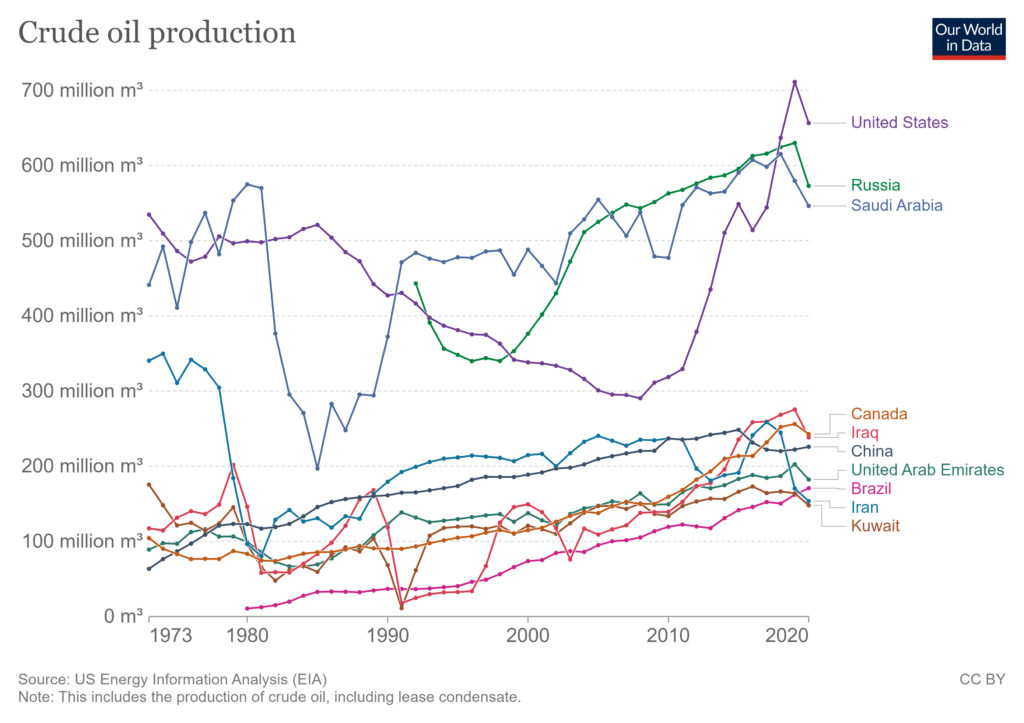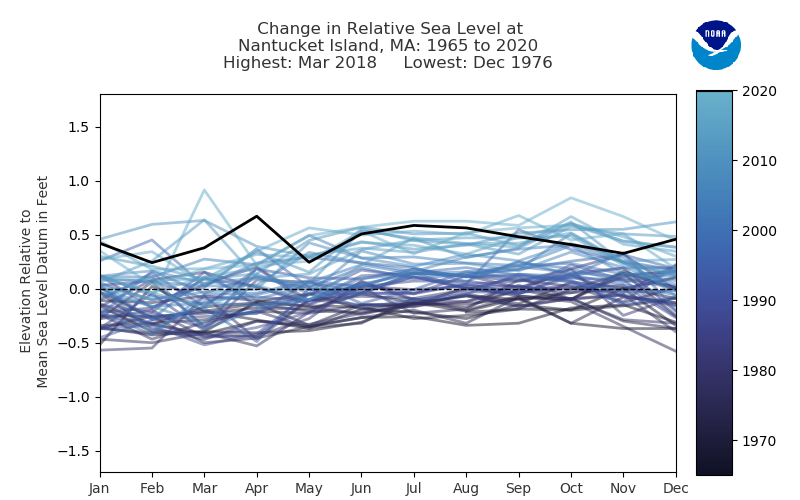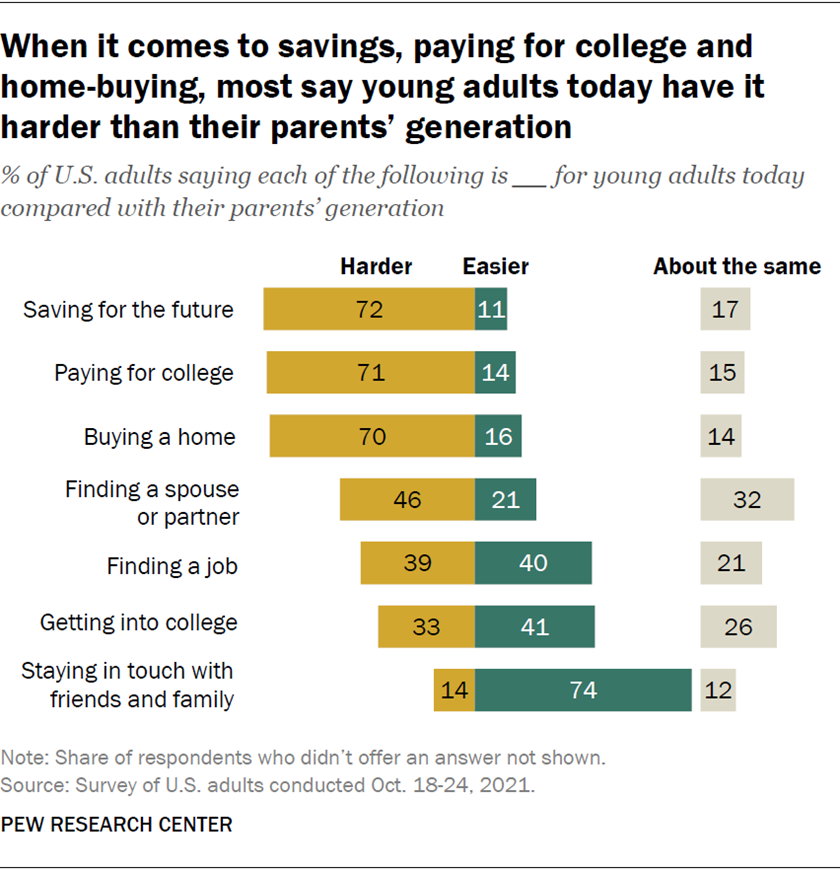 Our World in Data now has a Fossil Fuels Data Explorer. You can create a time series of the top ten oil producers, download the image, and post it on your favorite blog, which I did. Each of the top three more than doubles any producer in the 4-10 spot. Plenty to talk about in how this relates to global politics. The data is available as well as information for coal and natural gas.
Our World in Data now has a Fossil Fuels Data Explorer. You can create a time series of the top ten oil producers, download the image, and post it on your favorite blog, which I did. Each of the top three more than doubles any producer in the 4-10 spot. Plenty to talk about in how this relates to global politics. The data is available as well as information for coal and natural gas.
Do men always earn more than women?
 The Pew article, Young women are out-earning young men in several U.S. cities by Richard Fry (3/28/2022) provides the graph copied here.
The Pew article, Young women are out-earning young men in several U.S. cities by Richard Fry (3/28/2022) provides the graph copied here.
Overall, about 16% of all young women who are working full time, year-round live in the 22 metros where women are at or above wage parity with men.
There are four metro areas where young women make 110% or more of what young men make: Wenatchee, WA; Morgantown WV; Barnstable Town, MA; and Gainesville, FL.
From a regional perspective, metropolitan areas in the Midwest tend to have wider gender wage gaps among young workers. Young women working full time, year-round in Midwestern metros earn about 90% of their male counterparts. In other regions, by comparison, young women earn 94% or more of what young men earn.
The article doesn’t talk about the types of jobs or why disparities exist but they do note:
Labor economists examine earnings disparities among full-time, year-round workers in order to control for differences in part-time employment between men and women as well as attachment to the labor market. However, even among full-time, year-round workers, men and women devote different amounts of time to work. Men under 30 usually work 44 hours per week, on average, compared with 42 hours among young women.
There is a link to a Google sheet with the data for 250 U.S. metro areas at the bottom of the article.
When is your last freeze date?
 Climate.gov has an interactive map in their article Interactive map: average date of last spring freeze across the United States by Rebecca Lindsey (3/21/2022). A picture of the map is posted here. You can zoom in on a location and click a dot to get and exact data for the day the chance of freeze drops below 50%.
Climate.gov has an interactive map in their article Interactive map: average date of last spring freeze across the United States by Rebecca Lindsey (3/21/2022). A picture of the map is posted here. You can zoom in on a location and click a dot to get and exact data for the day the chance of freeze drops below 50%.
Places where this milestone is reached before the first day of spring in mid-March appear in shades of purple, while places where it comes after that are colored in shades of green. Clearly, from the amount of green, the odds of freezing air temperature remain above 50 percent until after the solar start of spring in most of the Lower 48. As you’d expect, the farther north or higher in elevation you go, the later in the season (darker greens) this day generally arrives.
At the bottom of there is a link to Annual/Seasonal Normals and how to get data for this graph and for other cutoff percentages.
What is the connection between flu and humidity?
The NASA post NASA Finds Each State Has Its Climatic Threshold for Flu Outbreaks (3/4/2022) summarizes the recent paper Spatial Variation in Humidity and the Onset of Seasonal Influenza Across the Contiguous United States by E. Sherman, et. el (12/13/2021). From the NASA Post:
Researchers at NASA’s Jet Propulsion Laboratory in Southern California and the University of Southern California correlated AIRS measurements of water vapor in the lower atmosphere with flu case estimates for each week from 2003 to 2015. The researchers found that in each state, there is a specific level of low humidity that may signal a flu outbreak is imminent. When this threshold is crossed each year, a large increase in flu cases follows within two or three weeks, on average.
The graph here is from the paper. The x-axis is the humidity level and the y-axis is the number of flu cases. One interesting feature is that all states have this clear ben in the scatter plot. The paper could be interesting for a stats course or maybe an independent project for students. Data availability is at the bottom of the paper.
How big is the Dem/Rep perception gap?
 More in Common did a perception gap study in 2018 and while it is a few years old it is worth reading. The graph copied here is the Democrats’ Perception Gap and the page has a similar one for Republicans. One interesting paragraph:
More in Common did a perception gap study in 2018 and while it is a few years old it is worth reading. The graph copied here is the Democrats’ Perception Gap and the page has a similar one for Republicans. One interesting paragraph:
Education is intended to make us better informed about the world, so we’d expect that the more educated you become, the more you understand what other Americans think. In fact, the more educated a person is, the worse their Perception Gap – with one critical exception. This trend only holds true for Democrats, not Republicans. In other words, while Republicans’ misperceptions of Democrats do not improve with higher levels of education, Democrats’ understanding of Republicans actually gets worse with every additional degree they earn. This effect is so strong that Democrats without a high school diploma are three times more accurate than those with a postgraduate degree.
The page has 11 graphs and would make a great QL source for discussion in a class. One key question to ask is if the gap has gotten better or worse over the last few years.
How hot was Feb 2022?
 From NOAA’s Global Climate Report – February 2022:
From NOAA’s Global Climate Report – February 2022:
The February 2022 global surface temperature was the seventh highest on record at 0.81°C (1.46°F) above the 20th century average. This value was 0.17°C (0.31°F) warmer than last year’s February value (2021), but 0.45°C (0.81°F) cooler than the record-warm February set in 2016.
Interestingly,
North America was the only continent to have a below-average February temperature at -0.40°C (-0.72°F); however, it didn’t rank among the top-20 cold February.
Data for the chart copied here is at a link at the top of the page under Temperature Anomalies Time Series.
What’s new at NASA’s Scientific Visualization Studio?
The visualization here is Zonal Climate Anomalies by Mark SubbaRao (3/7/2022).
The visualization presents monthly zonal temperature anomalies between the years 1880-2021. The visualization illustrates that the Arctic is warming much faster than other regions of the Earth.
The page has a link to the data that was used to create the visualization.
How much has sea level risen where you live?
If you live along the cost you might be interested in how much sea level has risen. Climat.gov has the answer on their page Interactive map: How has local sea level in the United States changed over time? by Rebecca Lindsey, et. el. (Updated 3/2/2022). Zoom in on the map at the top of the page and select an arrow and then click on >. This will take you to an animated graph showing has sea level has changed. You can download static versions, such as the one for Nantucket here, and there is a link to the data. Details about regional changes follow the map and are informative. For example, regarding the Gulf of Alaska:
Every coastal location on Earth is being affected by global sea level rise. So why are there a lot of downward arrows around the Gulf of Alaska? Here, global sea level rise is being offset because the land is rebounding as the last remnants of ice-age glaciers disappear. Global sea level is rising, but the land is rising faster, so sea level is falling relative to a fixed local benchmark.
What are the challenges for young adults?
The Pew article Most in the U.S. say young adults today face more challenges than their parents’ generation in some key areas by Stella Sechopoulos (2/28/20220) provides the survey response graph copied here. There are generational difference in these responses:
While majorities across all age groups say young adults have it harder when it comes to buying a home, saving for the future and paying for college, Americans ages 18 to 29 are more likely than older age groups to say this. More than eight-in-ten adults younger than 30 (84%) say buying a home is harder for young adults today, while 80% say the same about saving for the future and paying for college. Among those ages 30 to 49, 72% say buying a home and paying for college is harder for young adults today, and 74% say this about saving for the future. Those 50 and older are the least likely to say these measures are harder for younger generations to reach, with 63% saying this about buying a home, 67% saying this about saving for the future, and 66% saying this about paying for college.
A nice addition to this article would be data to back up the opinions. For example, are young adults saving less for the future than other generations and if so by how much?
There is another graph as well as questions used with the data and a methodology section.
What are the sources of methane emissions in the U.S.?
 The iea has a Methane Tracker Data Explorer which has information of methane emissions by country or for the world. In 2021 the U.S. emitted 31,460 kt of methane which is 8.8% of the global emissions. There are various graphs, such as the one copied here, and links to download the data.
The iea has a Methane Tracker Data Explorer which has information of methane emissions by country or for the world. In 2021 the U.S. emitted 31,460 kt of methane which is 8.8% of the global emissions. There are various graphs, such as the one copied here, and links to download the data.


